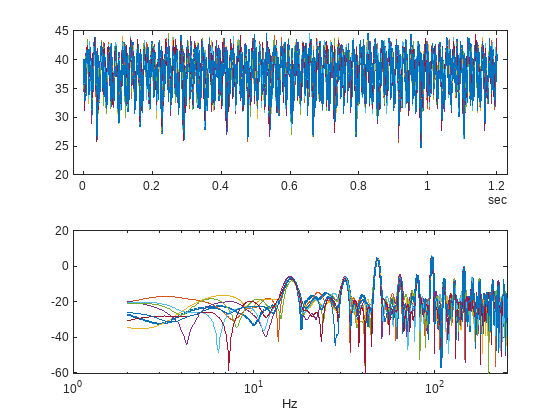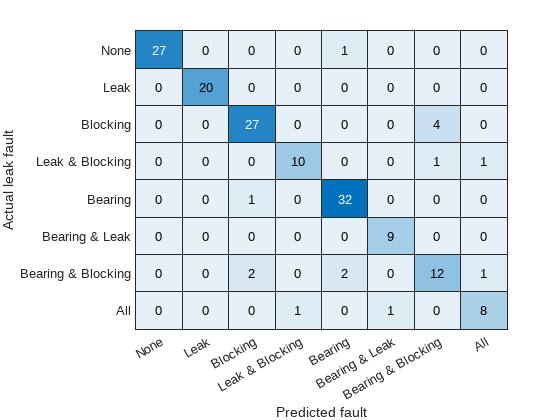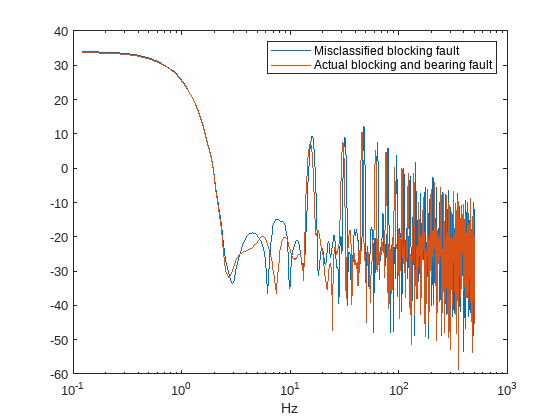シミュレーション データを使用した複数クラス故障検出
この例では、Simulink® モデルを使用して故障データと健全データを生成する方法を説明します。このデータを使用して、さまざまな故障の組み合わせを検出する複数クラス分類器を開発します。この例は 3 重往復ポンプ モデルを使用し、漏れ、閉塞、およびベアリングの故障を含みます。
モデルの設定
この例では、zip ファイルに保存されている多くのサポート ファイルを使用します。ファイルを解凍してサポート ファイルにアクセスし、モデル パラメーターを読み込みます。
unzip('pdmRecipPump_supportingfiles.zip') % Load Parameters pdmRecipPump_Parameters %Pump CAT_Pump_1051_DataFile_imported %CAD
往復ポンプ モデル
往復ポンプは、電気モーター、ポンプ ハウジング、ポンプ クランク、およびポンプ プランジャーで構成されています。
mdl = 'pdmRecipPump';
open_system(mdl)
open_system([mdl,'/Pump'])
ポンプ モデルは、シリンダーの漏れ、吸込口の閉塞、およびベアリング摩擦の増加という 3 タイプの故障をモデル化するように設定されます。これらの故障はワークスペース変数としてパラメーター化され、ポンプ ブロック ダイアログによって設定されます。

故障データと健全データのシミュレーション
3 つの故障タイプそれぞれについて、故障なしから重大な故障までの故障重大度を表す値の配列を作成します。
% Define fault parameter variations numParValues = 10; leak_area_set_factor = linspace(0.00,0.036,numParValues); leak_area_set = leak_area_set_factor*TRP_Par.Check_Valve.In.Max_Area; leak_area_set = max(leak_area_set,1e-9); % Leakage area cannot be 0 blockinfactor_set = linspace(0.8,0.53,numParValues); bearingfactor_set = linspace(0,6e-4,numParValues);
ポンプ モデルはノイズを含めるように設定されているため、同じ故障パラメーター値でモデルを実行すると、結果としてさまざまなシミュレーション出力が得られます。これは、同じ故障状態と重大度に対して複数のシミュレーション結果が可能であることを意味するので、分類器の開発に役立ちます。そのような結果が得られるシミュレーションを設定するには、故障パラメーター値のベクトルを作成します。ここで値は、故障なし、1 つの故障、2 つの故障の組み合わせ、および 3 つの故障の組み合わせを表します。故障なし、1 つの故障、などの各グループについて、上記で定義されている故障パラメーター値から、故障値の 125 の組み合わせを作成します。これにより故障パラメーター値の合計 1000 の組み合わせが得られます。これら 1000 のシミュレーションを並列で実行する場合、標準のデスクトップでは約 1 時間かかり、約 620 MB のデータが生成されることに注意してください。シミュレーション時間を短縮させるには、runAll = true を runAll = false に変更して、故障の組み合わせの数を 20 に減らします。データセットが大きいほど、よりロバストな分類器となることに注意してください。
% Set number of elements in each fault group runAll = true; if runAll % Create a large dataset to build a robust classifier nPerGroup = 100; else % Create a smaller dataset to reduce simulation time nPerGroup = 20; %#ok<UNRCH> end rng('default'); % Feed default seed to rng (Random number generator) % No fault simulations leakArea = repmat(leak_area_set(1),nPerGroup,1); blockingFactor = repmat(blockinfactor_set(1),nPerGroup,1); bearingFactor = repmat(bearingfactor_set(1),nPerGroup,1); % Single fault simulations idx = ceil(10*rand(nPerGroup,1)); leakArea = [leakArea; leak_area_set(idx)']; blockingFactor = [blockingFactor;repmat(blockinfactor_set(1),nPerGroup,1)]; bearingFactor = [bearingFactor;repmat(bearingfactor_set(1),nPerGroup,1)]; idx = ceil(10*rand(nPerGroup,1)); leakArea = [leakArea; repmat(leak_area_set(1),nPerGroup,1)]; blockingFactor = [blockingFactor;blockinfactor_set(idx)']; bearingFactor = [bearingFactor;repmat(bearingfactor_set(1),nPerGroup,1)]; idx = ceil(10*rand(nPerGroup,1)); leakArea = [leakArea; repmat(leak_area_set(1),nPerGroup,1)]; blockingFactor = [blockingFactor;repmat(blockinfactor_set(1),nPerGroup,1)]; bearingFactor = [bearingFactor;bearingfactor_set(idx)']; % Double fault simulations idxA = ceil(10*rand(nPerGroup,1)); idxB = ceil(10*rand(nPerGroup,1)); leakArea = [leakArea; leak_area_set(idxA)']; blockingFactor = [blockingFactor;blockinfactor_set(idxB)']; bearingFactor = [bearingFactor;repmat(bearingfactor_set(1),nPerGroup,1)]; idxA = ceil(10*rand(nPerGroup,1)); idxB = ceil(10*rand(nPerGroup,1)); leakArea = [leakArea; leak_area_set(idxA)']; blockingFactor = [blockingFactor;repmat(blockinfactor_set(1),nPerGroup,1)]; bearingFactor = [bearingFactor;bearingfactor_set(idxB)']; idxA = ceil(10*rand(nPerGroup,1)); idxB = ceil(10*rand(nPerGroup,1)); leakArea = [leakArea; repmat(leak_area_set(1),nPerGroup,1)]; blockingFactor = [blockingFactor;blockinfactor_set(idxA)']; bearingFactor = [bearingFactor;bearingfactor_set(idxB)']; % Triple fault simulations idxA = ceil(10*rand(nPerGroup,1)); idxB = ceil(10*rand(nPerGroup,1)); idxC = ceil(10*rand(nPerGroup,1)); leakArea = [leakArea; leak_area_set(idxA)']; blockingFactor = [blockingFactor;blockinfactor_set(idxB)']; bearingFactor = [bearingFactor;bearingfactor_set(idxC)'];
故障パラメーターの組み合わせを使用して Simulink.SimulationInput オブジェクトを作成します。各シミュレーション入力につき、異なる結果が生成されるようにランダム シードを必ず異なる値に設定します。
for ct = numel(leakArea):-1:1 simInput(ct) = Simulink.SimulationInput(mdl); simInput(ct) = setVariable(simInput(ct),'leak_cyl_area_WKSP',leakArea(ct)); simInput(ct) = setVariable(simInput(ct),'block_in_factor_WKSP',blockingFactor(ct)); simInput(ct) = setVariable(simInput(ct),'bearing_fault_frict_WKSP',bearingFactor(ct)); simInput(ct) = setVariable(simInput(ct),'noise_seed_offset_WKSP',ct-1); end
関数 generateSimulationEnsemble を使用して、上で定義された Simulink.SimulationInput オブジェクトによって定義されるシミュレーションを実行し、ローカル サブフォルダーに結果を格納します。次に、格納された結果から simulationEnsembleDatastore を作成します。
% Run the simulation and create an ensemble to manage the simulation % results if isfolder('./Data') % Delete existing mat files delete('./Data/*.mat') end [ok,e] = generateSimulationEnsemble(simInput,fullfile('.','Data'),'UseParallel',false,'ShowProgress',false); %Set the UseParallel flag to true to use parallel computing capabilities ens = simulationEnsembleDatastore(fullfile('.','Data'));
シミュレーション結果からの特徴の処理と抽出
このモデルはポンプの吐出圧力、出流量、モーター速度、およびモーター電流をログに記録するよう設定されます。
ens.DataVariables
ans = 8×1 string
"SimulationInput"
"SimulationMetadata"
"iMotor_meas"
"pIn_meas"
"pOut_meas"
"qIn_meas"
"qOut_meas"
"wMotor_meas"
アンサンブルのメンバーごとに、ポンプ出流量を前処理し、ポンプ出流量に基づいて状態インジケーターを計算します。状態インジケーターは後で故障分類のために使用されます。前処理のため、出流量の最初の 0.8 秒を削除します。これにはシミュレーションおよびポンプ始動からの過渡状態が含まれるためです。前処理の一部として、出流量のパワー スペクトルを計算し、SimulationInput を使って故障変数の値を返します。
対象とする変数だけが読み取りで返されるようにアンサンブルを設定し、この例の最後で定義されている関数 preprocess を呼び出します。
ens.SelectedVariables = ["qOut_meas", "SimulationInput"]; reset(ens) data = read(ens)
data=1×2 table
qOut_meas SimulationInput
__________________ ______________________________
{2001×1 timetable} {1×1 Simulink.SimulationInput}
[flow,flowP,flowF,faultValues] = preprocess(data);
流量と流量スペクトルをプロットします。プロットされるデータは故障なしの状態のものです。
% Figure with nominal subplot(211); plot(flow.Time,flow.Data); subplot(212); semilogx(flowF,pow2db(flowP)); xlabel('Hz')

流量スペクトルは、期待された周波数での共振ピークを示しています。具体的には、ポンプのモーター速度は 950 rpm、つまり 15.833 Hz であり、ポンプはシリンダーを 3 つもつため、流量は 3*15.833 Hz つまり 47.5 Hz で基本波であり、47.5 Hz の倍数において高調波であると予想されます。流量スペクトルは、期待される共振ピークを明確に示しています。ポンプの 1 つのシリンダーに故障が生じると、ポンプのモーター速度 15.833 Hz およびその高調波で共振が発生します。
流量スペクトルおよび低速信号は、可能な状態インジケーターをある程度示唆しています。具体的には、平均や分散などの一般的な信号統計量、およびスペクトル特性です。ピーク振幅の周波数、15.833 Hz 周辺のエネルギー、47.5 Hz 周辺のエネルギー、および 100 Hz を超えるエネルギーなどの、期待される高調波に関連するスペクトル状態インジケーターが計算されます。スペクトル尖度ピークの周波数も計算されます。
状態インジケーターのデータ変数および故障変数値の状態変数を使用して、アンサンブルを設定します。その後、関数 extractCI を呼び出して特徴を計算し、writeToLastMemberRead コマンドを使用して特徴および故障変数の値をアンサンブルに追加します。関数 extractCI はこの例の最後で定義されています。
ens.DataVariables = [ens.DataVariables; ... "fPeak"; "pLow"; "pMid"; "pHigh"; "pKurtosis"; ... "qMean"; "qVar"; "qSkewness"; "qKurtosis"; ... "qPeak2Peak"; "qCrest"; "qRMS"; "qMAD"; "qCSRange"]; ens.ConditionVariables = ["LeakFault","BlockingFault","BearingFault"]; feat = extractCI(flow,flowP,flowF); dataToWrite = [faultValues, feat]; writeToLastMemberRead(ens,dataToWrite{:})
上記のコードは、シミュレーション アンサンブルの最初のメンバーの状態インジケーターを前処理して計算します。アンサンブルの hasdata コマンドを使用して、アンサンブルのすべてのメンバーについてこれを繰り返します。さまざまな故障状態下におけるシミュレーション結果を把握するには、アンサンブルを 100 要素ごとにプロットします。
%Figure with nominal and faults figure, subplot(211); lFlow = plot(flow.Time,flow.Data,'LineWidth',2); subplot(212); lFlowP = semilogx(flowF,pow2db(flowP),'LineWidth',2); xlabel('Hz') ct = 1; lColors = get(lFlow.Parent,'ColorOrder'); lIdx = 2; % Loop over all members in the ensemble, preprocess % and compute the features for each member while hasdata(ens) % Read member data data = read(ens); % Preprocess and extract features from the member data [flow,flowP,flowF,faultValues] = preprocess(data); feat = extractCI(flow,flowP,flowF); % Add the extracted feature values to the member data dataToWrite = [faultValues, feat]; writeToLastMemberRead(ens,dataToWrite{:}) % Plot member signal and spectrum for every 100th member if mod(ct,100) == 0 line('Parent',lFlow.Parent,'XData',flow.Time,'YData',flow.Data, ... 'Color', lColors(lIdx,:)); line('Parent',lFlowP.Parent,'XData',flowF,'YData',pow2db(flowP), ... 'Color', lColors(lIdx,:)); if lIdx == size(lColors,1) lIdx = 1; else lIdx = lIdx+1; end end ct = ct + 1; end

さまざまな故障状態および重大度の下において、期待される周波数でスペクトルに高調波が含まれることに注意してください。
ポンプの故障の検出と分類
前の節では、シミュレーション アンサンブルの全メンバーの流量信号から状態インジケーターを前処理して計算しました。これはさまざまな故障の組み合わせと重大度によるシミュレーション結果に対応します。状態インジケーターを使用して、ポンプの流量信号からポンプの故障を検出し分類することができます。
状態インジケーターを読み取るようにシミュレーション アンサンブルを設定し、tall コマンドと gather コマンドを使用してすべての状態インジケーターと故障変数値をメモリに読み込みます。
% Get data to design a classifier. reset(ens) ens.SelectedVariables = [... "fPeak","pLow","pMid","pHigh","pKurtosis",... "qMean","qVar","qSkewness","qKurtosis",... "qPeak2Peak","qCrest","qRMS","qMAD","qCSRange",... "LeakFault","BlockingFault","BearingFault"]; idxLastFeature = 14; % Load the condition indicator data into memory data = gather(tall(ens));
Evaluating tall expression using the Local MATLAB Session: - Pass 1 of 1: Completed in 1 min 23 sec Evaluation completed in 1 min 23 sec
data(1:10,:)
ans=10×17 table
fPeak pLow pMid pHigh pKurtosis qMean qVar qSkewness qKurtosis qPeak2Peak qCrest qRMS qMAD qCSRange LeakFault BlockingFault BearingFault
______ ______ ______ ______ _________ ______ ______ _________ _________ __________ ______ ______ ______ ________ _________ _____________ ____________
95.749 7.4377 96.246 92.617 360.93 38.016 11.875 -0.70969 2.9885 19.839 1.1672 38.171 2.8614 45617 1e-09 0.8 0
95.81 8.7548 76.528 81.585 313.74 38.02 11.243 -0.66206 2.8867 19.554 1.1741 38.168 2.786 45624 1e-09 0.8 0
95.81 9.3164 95.741 81.76 278.15 38.017 11.414 -0.65767 2.8446 17.904 1.1493 38.167 2.8103 45622 1e-09 0.8 0
15.929 229.89 172.72 62.243 197.85 35.739 17.361 -0.21228 2.2656 19.259 1.2256 35.981 3.4465 42892 3.2e-06 0.8 0
15.929 308.95 176.6 47.473 197.85 35.453 19.394 -0.149 2.1681 19.761 1.2302 35.725 3.6708 42547 3.6e-06 0.8 0
95.81 13.846 112.04 80.069 118.38 37.708 11.663 -0.6497 2.8764 19.124 1.1707 37.863 2.8293 45249 4e-07 0.8 0
15.929 281.96 180.27 49.535 246.69 35.406 19.35 -0.14091 2.1397 18.987 1.2178 35.678 3.6818 42491 3.6e-06 0.8 0
47.906 130.47 147.47 66.197 152.32 36.271 14.607 -0.26691 2.3759 17.615 1.1962 36.472 3.1342 43527 2.4e-06 0.8 0
95.81 7.1699 98.464 92.378 186.26 38.005 11.575 -0.70257 2.8724 18.101 1.1548 38.157 2.8239 45608 1e-09 0.8 0
95.81 19.455 107.29 73.209 410.6 37.47 11.399 -0.52324 2.4842 16.94 1.1691 37.622 2.8115 44964 8e-07 0.8 0
アンサンブル メンバーごとの故障変数値 (データ テーブルの 1 行) を故障フラグに変換し、これらの故障フラグを、各メンバーのさまざまな故障ステータスを捕捉する 1 つのフラグに組み合わせることが可能です。
% Convert the fault variable values to flags
data.LeakFlag = data.LeakFault > 1e-6;
data.BlockingFlag = data.BlockingFault < 0.8;
data.BearingFlag = data.BearingFault > 0;
data.CombinedFlag = data.LeakFlag+2*data.BlockingFlag+4*data.BearingFlag;状態インジケーターを入力として受け取り、組み合わせた故障フラグを返す分類器を作成します。2 次多項式カーネルを使用するサポート ベクター マシンを学習させます。cvpartition コマンドを使用して、アンサンブルのメンバーを学習用のセットと検証用のセットに分割します。
rng('default') % for reproducibility predictors = data(:,1:idxLastFeature); response = data.CombinedFlag; cvp = cvpartition(size(predictors,1),'KFold',5); % Create and train the classifier template = templateSVM(... 'KernelFunction', 'polynomial', ... 'PolynomialOrder', 2, ... 'KernelScale', 'auto', ... 'BoxConstraint', 1, ... 'Standardize', true); combinedClassifier = fitcecoc(... predictors(cvp.training(1),:), ... response(cvp.training(1),:), ... 'Learners', template, ... 'Coding', 'onevsone', ... 'ClassNames', [0; 1; 2; 3; 4; 5; 6; 7]);
検証データを使用して学習後の分類器の性能をチェックし、結果を混同プロットにプロットします。
% Check performance by computing and plotting the confusion matrix actualValue = response(cvp.test(1),:); predictedValue = predict(combinedClassifier, predictors(cvp.test(1),:)); confdata = confusionmat(actualValue,predictedValue); figure, labels = {'None', 'Leak','Blocking', 'Leak & Blocking', 'Bearing', ... 'Bearing & Leak', 'Bearing & Blocking', 'All'}; h = heatmap(confdata, ... 'YLabel', 'Actual leak fault', ... 'YDisplayLabels', labels, ... 'XLabel', 'Predicted fault', ... 'XDisplayLabels', labels, ... 'ColorbarVisible','off');

混同プロットは、故障の各組み合わせにつき、故障の組み合わせが正しく予測された回数 (プロットの対角エントリ) と、故障の組み合わせが誤って予測された回数 (非対角エントリ) を示しています。
混同プロットから、分類器は一部の故障状態を正しく分類しなかった (非対角項) ことがわかります。しかし、全体的な検証精度は 90% で、故障があることを予測する精度は 100% です。
% Compute the overall accuracy of the classifier
sum(diag(confdata))/sum(confdata(:))ans = 0.9062
% Compute the accuracy of the classifier at predicting % that there is a fault 1-sum(confdata(2:end,1))/sum(confdata(:))
ans = 1
故障が誤って予測されたケースについて調べます。検証データで、実際の故障が閉塞故障でありながら、ベアリングの故障と閉塞故障であると予測されたケースを見つけます。
vData = data(cvp.test(1),:); b1 = ((actualValue==2) & (predictedValue==6)); fData = vData(b1,15:17)
fData=4×3 table
LeakFault BlockingFault BearingFault
_________ _____________ ____________
1e-09 0.53 0
4e-07 0.59 0
8e-07 0.71 0
4e-07 0.59 0
閉塞故障のみが存在する場合に、ベアリングの故障と閉塞故障の両方が予測されたケースを調べてみると、漏れ故障値がノミナル値 1e-9 に近く、閉塞故障値が約 0.6、ベアリング故障値がノミナル値 0 である場合に生じることが明らかになります。故障の誤分類があるケースと実際の故障 (ベアリングと閉塞の両方) があるケースのスペクトルをプロットすると、スペクトルがよく似ているために検出が困難になることがわかります。追加のポンプ測定値を使用してさらに多くの情報を提供することにより、小さな閉塞故障を検出できるように機能を改善することができます。あるいは、特定の周波数帯域のエネルギーを調べる特徴を調査することで、性能を向上させることもできます。
% Configure the ensemble to only read the flow and fault variable values ens.SelectedVariables = ["qOut_meas","LeakFault","BlockingFault","BearingFault"]; reset(ens) % Load the ensemble member data into memory data = gather(tall(ens));
Evaluating tall expression using the Local MATLAB Session: - Pass 1 of 1: Completed in 2 min 34 sec Evaluation completed in 2 min 34 sec
% Look for the member that was incorrectly predicted, and % compute its power spectrum idx = ... data.BlockingFault == fData.BlockingFault(1) & ... data.LeakFault == fData.LeakFault(1) & ... data.BearingFault == fData.BearingFault(1); flow1 = data(idx,1); flow1 = flow1.qOut_meas{1}; [flow1P,flow1F] = pspectrum(flow1); % Look for a member that has blocking and bearing faults idx = ... data.BlockingFault == 0.53 & ... data.LeakFault == 1e-9 & ... data.BearingFault == 6e-4; flow2 = data(idx,1); flow2 = flow2.qOut_meas{1}; [flow2P,flow2F] = pspectrum(flow2); % Plot the power spectra semilogx(... flow1F,pow2db(flow1P),... flow2F,pow2db(flow2P)); xlabel('Hz') legend('Misclassified blocking fault','Actual blocking and bearing fault')

まとめ
この例では Simulink モデルを使用して、往復ポンプの故障をモデル化し、さまざまな故障の組み合わせと重大度の下でモデルをシミュレートして、ポンプの出流量から状態インジケーターを抽出し、その状態インジケーターを使用してポンプの故障を検出するための分類器を学習させる方法を示しました。ここでは分類器を使用した故障検出の性能を調べ、閉塞故障はベアリング故障と閉塞故障の状態によく似ているため正確に検出できないことを確認しました。
サポート関数
function [flow,flowSpectrum,flowFrequencies,faultValues] = preprocess(data) % Helper function to preprocess the logged reciprocating pump data. % Remove the 1st 0.8 seconds of the flow signal tMin = seconds(0.8); flow = data.qOut_meas{1}; flow = flow(flow.Time >= tMin,:); flow.Time = flow.Time - flow.Time(1); % Ensure the flow is sampled at a uniform sample rate flow = retime(flow,'regular','linear','TimeStep',seconds(1e-3)); % Remove the mean from the flow and compute the flow spectrum fA = flow; fA.Data = fA.Data - mean(fA.Data); [flowSpectrum,flowFrequencies] = pspectrum(fA,'FrequencyLimits',[2 250]); % Find the values of the fault variables from the SimulationInput simin = data.SimulationInput{1}; vars = {simin.Variables.Name}; idx = strcmp(vars,'leak_cyl_area_WKSP'); LeakFault = simin.Variables(idx).Value; idx = strcmp(vars,'block_in_factor_WKSP'); BlockingFault = simin.Variables(idx).Value; idx = strcmp(vars,'bearing_fault_frict_WKSP'); BearingFault = simin.Variables(idx).Value; % Collect the fault values in a cell array faultValues = {... 'LeakFault', LeakFault, ... 'BlockingFault', BlockingFault, ... 'BearingFault', BearingFault}; end function ci = extractCI(flow,flowP,flowF) % Helper function to extract condition indicators from the flow signal % and spectrum. % Find the frequency of the peak magnitude in the power spectrum. pMax = max(flowP); fPeak = flowF(flowP==pMax); % Compute the power in the low frequency range 10-20 Hz. fRange = flowF >= 10 & flowF <= 20; pLow = sum(flowP(fRange)); % Compute the power in the mid frequency range 40-60 Hz. fRange = flowF >= 40 & flowF <= 60; pMid = sum(flowP(fRange)); % Compute the power in the high frequency range >100 Hz. fRange = flowF >= 100; pHigh = sum(flowP(fRange)); % Find the frequency of the spectral kurtosis peak [pKur,fKur] = pkurtosis(flow); pKur = fKur(pKur == max(pKur)); % Compute the flow cumulative sum range. csFlow = cumsum(flow.Data); csFlowRange = max(csFlow)-min(csFlow); % Collect the feature and feature values in a cell array. % Add flow statistic (mean, variance, etc.) and common signal % characteristics (rms, peak2peak, etc.) to the cell array. ci = {... 'qMean', mean(flow.Data), ... 'qVar', var(flow.Data), ... 'qSkewness', skewness(flow.Data), ... 'qKurtosis', kurtosis(flow.Data), ... 'qPeak2Peak', peak2peak(flow.Data), ... 'qCrest', peak2rms(flow.Data), ... 'qRMS', rms(flow.Data), ... 'qMAD', mad(flow.Data), ... 'qCSRange',csFlowRange, ... 'fPeak', fPeak, ... 'pLow', pLow, ... 'pMid', pMid, ... 'pHigh', pHigh, ... 'pKurtosis', pKur(1)}; end